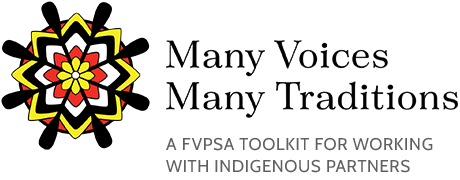A note about language
Readers will note that the term “Tribes” is used throughout this section specifically rather than Indigenous Nations. The language shift in this section is due to the terminology and definitions used by the FVPSA statute and regulations as it relates to eligibility to receive FVPSA funding directly from the Federal government.
Federal FVPSA Funding Overview
As described in the Funding Allocation section, the FVPSA Statute authorizes the FVPSA Office to provide 10% of congressionally appropriated funds directly to Tribes through the mandatory formula grants. The FVPSA Office releases Funding Opportunity Announcements (FOA) that detail how to apply for the funding. FVPSA releases their mandatory FOA’s through Standing Announcements. In order to receive the grants certain eligibility criteria must be met as outlined in the FVPSA Statute at 42 U.S.C. § 10409(b). According to the FVPSA Tribal FOA, potential grantees must be one of the following:
- Federally recognized Indian Tribes, alone or through a consortium 1
- A tribal organization authorized to submit an application and receive funds on the behalf of a Federally recognized Indian Tribe
- A non-profit organization authorized to submit an application and receive the funds on the behalf of a Federally recognized Indian Tribe
Funding levels are determined by Congressional appropriation and may vary from year to year. The Administration for Children and Families (ACF) (where the FVPSA Office is located) uses a formula to determine how much an individual Tribe will receive. The formula has both a baseline funding component and a Tribal Population component. Other factors that influence the award amount include how many Tribes apply for funding in any given year and whether Tribes apply individually or as part of a consortium. Details related to baseline funding amounts and which Tribal Population numbers are utilized in the formula are detailed in the Tribal FOA released by the FVPSA office.
In addition to mandatory formula funding, ACF offers competitive, also known as discretionary, funding opportunities. Discretionary funding can vary depending on funding levels. Eligibility for each discretionary funding opportunity, the purpose of each opportunity, and funding available are detailed in the FOA’s. Tribes are encouraged to review FOA’s as they are released to determine if they are eligible and if they want to pursue the funding.
Accessing Federal FVPSA Funds
Although the mandatory formula grants are non-competitive, Tribes must apply for the funding every year as required by FVPSA Statute at 42 U.S.C. § 10409(d). The FVPSA Office releases FOAs via Grants.gov. The FOA outlines all applicable criteria a Tribe must meet in order to receive funding including all relevant Federal Government requirements and those contained in the FVPSA Statute at 42 U.S.C. § 10401 et seq., FVPSA regulations at 45 CFR § 1370, and the Uniform Administrative Requirements, Cost Principles, and Audit Requirements for HHS Awards at 45 CFR § 75.
Tribal Consortiums
Tribes can apply individually or as a consortium. The Tribal FOA defines a consortium as:
A partnership between one or more tribes (including qualifying Alaska Native villages and entities) that authorizes a single tribal organization or nonprofit to submit an application and administer the FVPSA grant funds on their behalf.
As long as the main applicant is a federally recognized tribe, non-federally recognized tribes may join in partnership with the main applicant. According to the FVPSA Tribal FOA, “If a tribal consortium applies on behalf of multiple tribes, the entity (tribe, tribal organization, or nonprofit private organization) applying as the responsible party for the grant will receive the total award, and each tribe will be allocated funds based on the population formula that together will comprise the total amount of the award.” It should be noted that Tribes who apply as part of a consortium for Federal FVPSA funds, may also apply for FVPSA funding through their State as an individual entity as the two processes are separate and are separate funding streams.
Tribes applying as consortiums should be sure to review the Tribal FOA thoroughly to ensure they are following all additional steps that may apply (ex. A signed tribal resolution from each tribe in the consortium must be submitted with the application). Joining a consortium is an individual Tribe’s decision, and Tribes may decide to partner with as many or fewer tribes as they like. There are no requirements to stay in a consortium from year to year. A Tribe may choose to stay in the same consortium, join a different consortium, or apply individually during each new funding cycle. Forming consortiums allows tribes to combine funds in hope of serving more survivors. Smaller tribes may benefit by gaining access to increased, shared funds and reduction of grant management burdens. Combining resources may also allow for tribes to increase their service area and resources.
